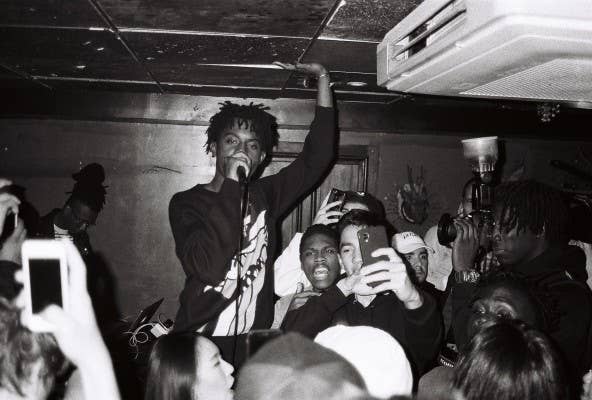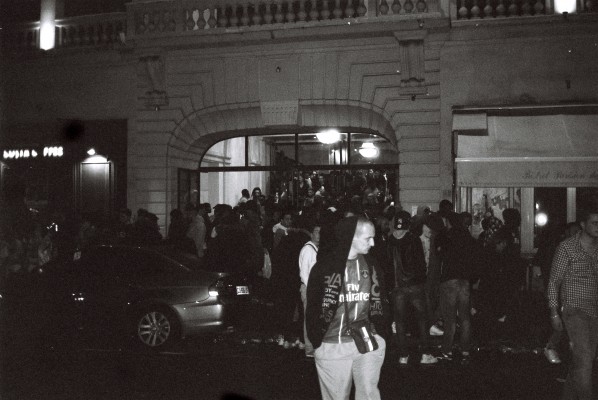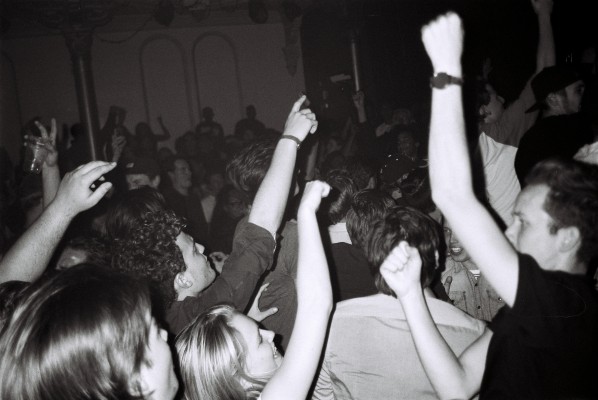
1.

Playboi Carti performs in Paris
I first decided to move to Paris on top of the water tower at my friend Alex’s apartment building in New York. It had been a dream of mine for two years, a romanticized idea that first got a hold of me during a six-hour layover in the French capital when I watched the sun come up over the Eiffel Tower.
Two years later it was around 11 p.m. in the late New York summer. Carlo Rossi Chablis was in our veins, and it occurred to me that by crashing on my friends’ couches for the next month (thank you Luigi, Sam, Euan, Hal, and Clarke), I could save up enough for a ticket to France.
Weaving through cars and taxicabs for the next month, I bike couriered my way to the counter at John F. Kennedy Airport. It was another adventure, another spot on a seemingly endless list of places I want to live.
A plane ride later, I watch as rain slowly starts to fall and trickle down the beautiful cobbled bricks of Montmartre. Knee-deep balconies gleam with the dressings of summer—small bouquets of red, yellow, and more yellow hang delicately while plumes of cigarette smoke blow across from the neighboring apartments. The buzz of Vespas drone by as the whispers of a new language escape my grasp. The cold water engulfs my canvas sneakers, and my wet shoe gradually shrinks to the shape of my foot. My suitcase in hand, Alex at my side, address in my phone. It’s 5 p.m. at Place De Clichy, Paris, France.
And then I hear it. Young Thug’s “Check” is playing.
Not in my headphones, not from my iPhone, but from some random teenagers hanging out in front of the Métro (Paris’ subway system). The anxious shell of being a foreigner melts away and we exchange nods. Alex and I can’t help but sing along. It’s as if all the uneasiness of this new world is suddenly grounded with a few familiar staccato punch lines. The chorus starts to roll and soon falls one half-step behind the baby kicks of the beat. Me and Alex are yelling, bounding down the street. Metro Boomin on production.
I am home.
The export of American rap music is not a new phenomenon. 2Pac, Biggie, Jay Z, 50 Cent, Big L, and many more American rappers made waves in Europe. The last twenty years have contained a transatlantic exchange that recalls the ’60s, when English rockers sang their way into America’s heart.
It would later be playfully named the British Invasion, and would forever change the course of counterculture and rebellion during the second half of the 20th century. Today, 16 years into the 21st, and following a transition away from rock and roll, Atlanta’s rap scene can be likened to Liverpool. Kanye West has replaced the Beatles, Kendrick Lamar the Rolling Stones, Travis Scott The Kinks. In the same eager way America once devoured British rock, Europe has been lapping up every available vestige of American hip-hop culture.
3.

Kids mosh to Post Malone in Amsterdam
The room moves to the beat of “Blood On The Money,” swivels to Father’s “Look At Wrist.” Drinks in clear plastic cups are traded happily for euros, the crowd is young, the drinking age is adequate, and Playboi Carti’s Fuck Fashion Week party is in full effect. It’s my first night in France, and Paris is picking up right where New York left off.
I’m introduced to a few French kids by a friend of mine, but I can hardly hear more than a few words over Drake and Future’s What a Time. The sound system is powerful, but the language barrier is even stronger, and I realize it’s better to exchange trap arms than spoken greetings. Bodies mosh to Skepta and Kanye as the sweaty basement awaits Carti.
With only 15 songs on Soundcloud and no album out, conventional wisdom doesn’t point to Playboi Carti being the most obvious headliner—especially not in Paris. But conventional wisdom doesn’t matter when you’re feeding a crowd’s hunger, and the venue is packed to the brim, with a line stretching down the block.
It’s a testament to just how popular American rap music is today in Europe, but it also shows just how important the entire hip-hop culture has become. With Ian Connor squarely in his corner and an Off-White modeling gig under his belt, Carti isn’t just 15 songs. He’s the art, he’s the fashion, and it’s no coincidence that the kids anxiously waiting around me are decked out in Supreme, KTZ, and Off-White.
Carti hits the stage, the crowd rushes close, and the French pepper the room with accented lyrics from his catalog. The space tightens and expands with the music. In the mosh, record deals and albums don’t matter. Carti is a superstar. “Broke Boi” is rapped word for word. The ceiling is low; the energy is high.
Hip-hop has spread like wildfire in recent years. Unknowns such as Bobby Shmurda, Post Malone, Playboi Carti, and OT Genasis have skyrocketed to popularity almost overnight on the basis of one or two songs. Their success has completely stripped away the validity of the record deal/radio play route to mainstream popularity. Social media is acting as the great equalizer, giving a wider audience a wider variety of culture than ever before.
European youth is consuming American hip-hop in high doses, but this isn’t American imperialism. It’s far from an embrace of all American culture. These kids want to be involved with a specific and pointed counterculture.
It’s what makes a song like “I Know There’s Gonna Be (Good Times)” possible, and it explains why London is one of the top cities streaming Young Thug on YouTube. It’s how Post Malone is able to sell out a show in Amsterdam, when it took Jay Z or Kanye West years to get across the Atlantic, a trip 2Pac would never even make.
“Check” is playing again.
This time Young Thug is actually performing live. The music is loud, the song unmistakable—the only problem is, I’m outside. It’s Thug’s second night in Paris, and even the scalped tickets are sold out. A small group stands outside Le Trianon near Pigalle. Occasionally one ventures to the bouncers to try their story, but to no avail. The night is winding down. Discouraged, Alex and I wait in a nearby coffee shop to see the fans exit.
6.

Fans exit Young Thug’s show at Le Trianon, Paris
Suddenly, the doors burst open and kids clad in Supreme, and Palace, Ksubi, and ripped white tees begin to pour out of the venue. Some sport small Euro purses, the same ones Skepta has begun to popularize here in the States. Steam evaporates into the air as the beads of sweat dry on their faces. The air is thick with jubilation. Alex and I begin our walk home, smiling.
Place de la Republique is crowded. Converse clad skateboarders in light Levi jeans. The homeless have their corners, the lovers sit curled up on benches, and at the center, kids who would be best but inadequately described as hypebeasts listen to Travis Scott’s latest album through crackling speakers. Tight, ripped denim give way to Jordan 4s and throwback Air Max 90s, Yeezus tour tees, and Off-White sleeves. “Nightcrawler” plays. They dance, they flirt, bottles are passed, they drink. The kids revel in the music of the hour as their parents wonder where they might be. It’s delinquency at its finest.
After coming home victorious from WWII, the U.S.A in the 1950s was a country happily embracing growth and stability. The postwar economy was booming and families were finally settling into life without overseas madness and horror. Left over from the war, however, was America’s fear of communism, and as a result the ’50s were an era of conservatism, patriotism, and Cold War fears.
About a decade later, this conformist mentality would reach a boiling point among America’s youth. Social restrictions and taboos were broken, leading to an explosion of counterculture known simply as “the ’60s.” Enter Beatlemania, The Stones, The Yardbirds, long hair, psychedelia, mini skirts, sex, drugs, and rock and roll. With help from the U.K., Americans were finally able to free themselves and say “fuck off” to their parents through new forms of expression. A similar cultural rebellion is reverberating across Europe.
8.

Kids mosh to Post Malone, Amsterdam
When I finally reach Amsterdam for what would be my final month in Europe, I was curious to see if what I had witnessed was regional. Maybe, I thought, such a cultural invasion was only reserved for the uber-metropolitan hubs of London and Paris.
I was wrong. There are 300+ Dutch kids standing outside the Melkveg—a popular Amsterdam club—in the rain, waiting for Post Malone. Inside, it’s every bit as chaotic as Paris. The kids sway and mosh while Malone wails the chorus to “White Iverson.” There probably isn’t a face in the crowd who could pin down Iverson’s first name, but they watch enthralled as Malone tiptoes across the stage in skinny jeans and red-strapped Margielas.
If it isn’t an invasion, I’m not quite sure how one characterizes it—maybe it’s more of a siege. My time in Europe showcased the incredible, social media-fueled popularity hip-hop holds today. It brings to mind a quote Kanye West made in his interview with the BBC Radio 1’s Zane Lowe: “Rap is the new rock and roll.”
In truth, there will never be another rock and roll. But something is happening here, and the root of Kanye’s point holds true. Rock and rap share far too many parallels to ignore, their similar revolts separated only by a generation. What made rock and roll so damn special was its ability to bring people together, to cross borders, and then seemingly erase them completely. Rap is beginning to do the same. Just ask the kids in Paris by the subway, ask all 300 of us in line for Post Malone, ask the ones packed in the basement waiting for Playboi Carti. They’re all part of something big, something that hasn’t been seen in more than 50 years, and something that could be talked about for 50 years to come.

